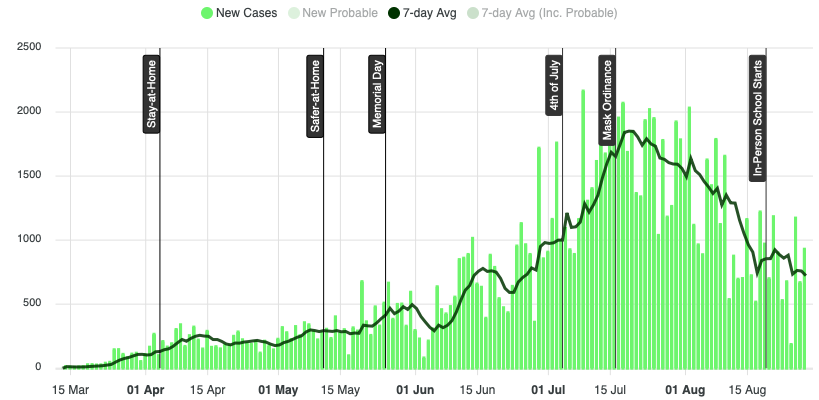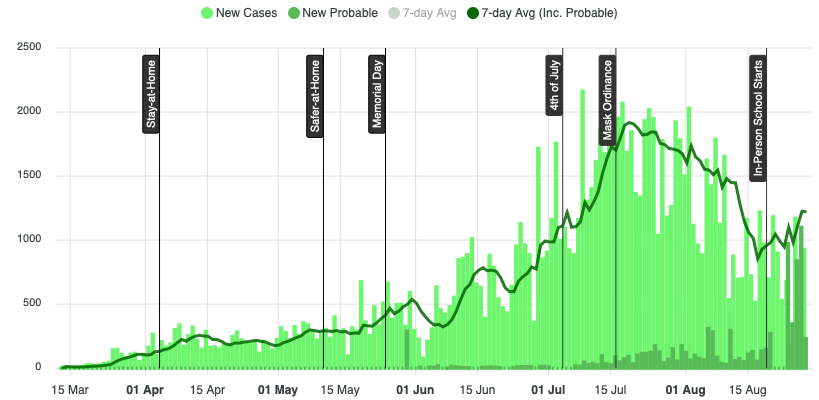Alabama’s coronavirus numbers were muddled over the last seven days as some metrics indicated slight progress while others did not provide positive signs.
Hospitalizations are down slightly from when Yellowhammer News last provided an update one week ago, and new cases, according to how they have been traditionally recorded, are down as well.
However, the percentage of tests coming back positive has risen, and a new type of “probable cases” has been added to the coronavirus data dashboards that indicates the total number of infected may be up from where it was last week.
The Alabama Department of Public Health defines probable cases as “the total number of patients who are epidemiologically linked (have had close contact) with a confirmed case, have symptoms meeting clinical criteria of COVID-19, and have no confirmatory laboratory testing performed for COVID-19.”


Alabama Media Group opinion columnist Kyle Whitmire reported on Friday that the Alabama Department of Public Health includes all people who receive a positive result on a rapid test as a ‘probable’ new case instead a confirmed new case.
Rapid tests, sometimes referred to by the more scientific title antigen-tests, have grown in popularity recently for their ability to provide same day results.
The more traditional tests that are sent to official laboratories are often referred to as molecular tests or gold standard tests.
It appears the ADPH does not believe rapid tests, such as those made by Abbott Labs, provide “confirmatory laboratory testing” reliable enough to include in the official counts.
Official CDC guidance backs up this policy, saying that the rapid tests are “generally less sensitive” than the ones that are sent to a laboratory.
However, the CDC also says that the first two rapid tests to hit the market are 84% and 97%, respectively, as effective as the traditional molecular tests that are sent to a lab, indicating a very high probability that someone who gets a positive result on a rapid test has the coronavirus.
Many individuals receiving a positive result on a rapid test are then told to get a molecular test to confirm the result, indicating they would likely be entered into the traditional case count soon afterwards.
If not including the ‘probable’ cases Alabama’s seven-day average of new cases has fallen from 855 to 722.
When ‘probable’ cases are included, the same average goes from 985 a week ago to 1,222 on Friday.
Both numbers are far below the peak of nearly 2,000 new cases per day during the third week of July.
In more solidly positive news, the number of Alabamians being hospitalized each day was 96 over the last week, down from an average of 116 on August 20.
Troubling to experts is that the percentage of tests being conducted in Alabama that came back positive for COVID-19 rose to 9.26% from a low of 6.43% one week ago.
BamaTracker, a coronavirus database that Yellowhammer News has used for reference in this article, says the ideal range for positivity percentage is 5% or below.
Out of Alabama’s 67 counties, 61 reported a new coronavirus case on Friday, indicating continued widespread transmission of the virus around the state. The percentage of Alabama’s counties reporting a new case is nearly identical to one week ago.
Alabama averaged 13 deaths per day from COVID-19 over the last seven days, roughly the same on a week to week basis as where the state was on August 20.
When Yellowhammer has referenced “a week ago” in this piece it is a reference to the August 20, the last time a coronavirus numbers update was published.
Dr. Jodie Dionne-Odom from UAB’s Division of Infectious Diseases briefed reporters on Friday morning.
“We’re doing better in the State of Alabama,” began Dionne-Odom.
“Since Governor Kay Ivey had the mask order put in place on July 14 we’ve seen a nice decrease in the number of cases,” she added.
RELATED: Ivey extends mask order to October 2
Henry Thornton is a staff writer for Yellowhammer News. You can contact him by email: [email protected] or on Twitter @HenryThornton95













